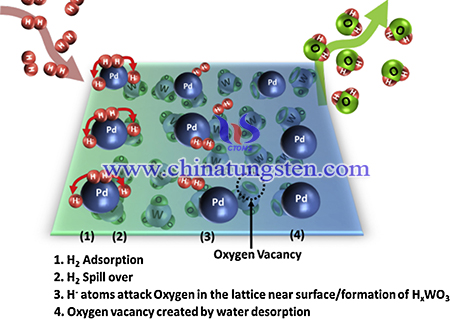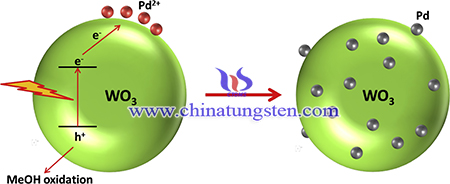Pd Nanoparticles Doped on WO3 Using APT as Raw Material for Gasochromic Sensing of Hydrogen
- Details
- Category: Tungsten Information
- Published on Sunday, 11 July 2021 00:15
Currently, due to the environmental situation worsening, in various countries and especially in the large cities, more and more funds have been allocated for the development of the green energy industry and environmentally friendly technologies. Hydrogen energy is an energy source that has increased its popularity in recent years. It is a clean energy source that can be used instead of fossil fuels. Hydrogen it can be used instead of fossil fuels due to its higher energy content and less environmental impact. The density of hydrogen is lower than the density of air. The gravimetric density of hydrogen energy is generally about seven times higher than the density of fossil fuels.
However, hydrogen is highly volatile, explosive, and inflammable gas and it is dangerous when its concentration exceeds the lower flammable limit in air ambience, that is concentration of only 4%. Hydrogen is a colorless, odorless and tasteless flammable gas and thus cannot be detected by human senses, and therefore other means are required to detect its presence and quantify the concentration for the safety reasons.WO3 is one of the most attractive materials for hydrogen gas sensing applications covering a wide range of concentrations and fast response. Thus, Pd nanoparticles has been successfully doped on WO3 using APT as raw material for gasochromic sensing of hydrogen.

The synthesis method of WO3-Pd nano material is as following steps: 1 g of ammonium paratungstate was dissolved in 95 ml de-ionized water. 2.5 ml of concentrated HCl was added to the above aqueous solution and stirred for 30 min. 2.5 ml of H2O2 was then added and stirred vigorously for 1 h to form peroxopolytungstic acid precursor solution. This solution was transferred to a teflon-lined autoclave, filling 80% of the autoclave. The hydrothermal synthesis was carried out at 160 °CC for 2 h. After the synthesis, the autoclave was allowed to cool down to room temperature and precipitate was filtered, washed several times with water and dried. As synthesized WO3·0.33H2O nanoparticles were annealed at 500 °C for 2 h to obtain pure crystalline monoclinic WO3.

The palladium precursor solution required for photochemical deposition was obtained by making 0.25 mM PdCl2 solution in methanol with 2 h of sonication and vigorous stirring for 1 h. The deposition solution was prepared by adding 100 mg of synthesized WO3 nanoparticles in 40 ml methanol and 10 ml palladium precursor solution (0.25 mM PdCl2 in methanol) and 5 mg of PVP (polyvinylpyrrolidone, MW ≈ 40,000). The deposition solution was then exposed to UV light for 2 min with vigorous stirring to deposit Pd on WO3 nanoparticles. Fig. 1 shows graphical presentation of photochemical deposition of Pd on WO3 nanoparticles. During the UV irradiation, WO3 generates electron–hole pair. The photo-generated electrons are utilized to reduce Pd2+ to Pd metal nanoparticles. And photo-generated holes are diffused to oxidize methanol in the solution. After UV irradiation, the color of the solution changed from brown to dark gray (Fig. S1) indicating the formation of Pd metal nanoparticles. The solution was then centrifuged and washed several times with methanol and finally dried in oven for 60 °C overnight. Hydrogen gas sensing samples were made by adding WO3–Pd nanoparticles in 5 ml methanol followed by sonicating and dispersing on filter paper to investigate gasochromic and electrical hydrogen sensing properties. To test optical hydrogen sensing properties, WO3–Pd nanoparticles were spin-coated on (2500 rpm for 60 s) glass slides and dried in air.
In summary, Pd nanoparticles has been successfully doped on WO3 using APT as raw material for gasochromic sensing of hydrogen. Experimental results show that PVP played a very important role in the photochemical deposition of Pd onto WO3 nanoparticles. As a hydrogen sensor, the WO3–Pd nanocomposite showed significant and fast response at room temperature with appreciable recovery time. Hence, the controlled deposition and excellent performance of WO3–Pd sensors at room temperatures strongly suggests a promising method for the synthesis and development of an advanced multi-functional semiconductor hydrogen sensor.
- APT Manufacturer & Supplier, Chinatungsten Online: ammonium-paratungstate.com
- Tungsten News & Prices of China Tungsten Industry Association: www.ctia.com.cn
- Molybdenum News & Price: news.molybdenum.com.cn
- Tel.: 86 592 5129696; Fax: 86 592 5129797; Email: sales@chinatungsten.com



 sales@chinatungsten.com
sales@chinatungsten.com